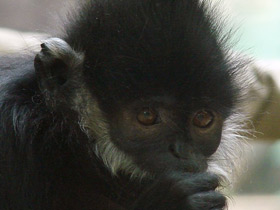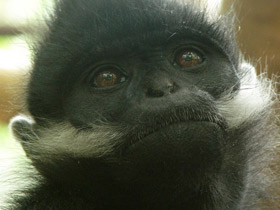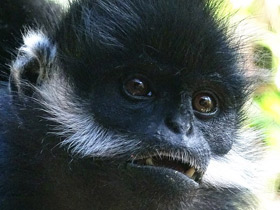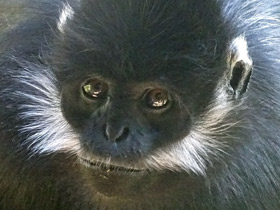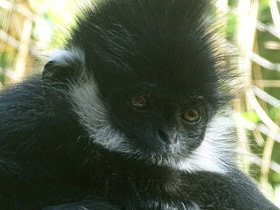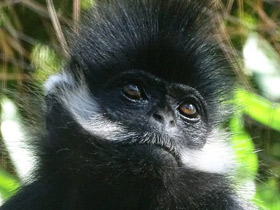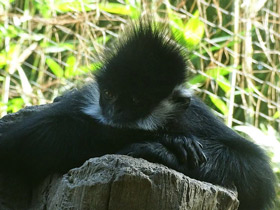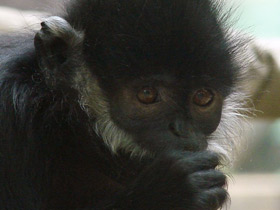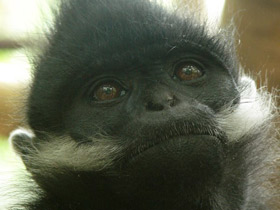François' langur (Trachypithecus francoisi), Francois' leaf monkey, the Tonkin leaf monkey, or the white side-burned black langur
François' langur (Trachypithecus francoisi), also known as Francois' leaf monkey, the Tonkin leaf monkey, or the white side-burned black langur is a species of Old World monkey and the type species of its species group. It is one of the least studied of the species belonging to the Colobinae subfamily.
The species is distributed from Southwestern China to northeastern Vietnam. The total number of wild individuals is unknown, but fewer than 500 are believed to be left in Vietnam and 1,400–1,650 in China. About 60 langurs are in captivity in North American zoos. The species is named after Auguste François (1857–1935), who was the French Consul at Lungchow in southern China.
Habitat and nutrition
Trachypithecus francoisi is a species of catarrhine primate in the family Cercopithecidae; it is the type species of the genus. Trachypithecus francoisi is common in southern China (Chongqing, Guangxi, Guizhou and Sichuan provinces) and northeastern Vietnam. This species is found in subtropical monsoonal and tropical and humid subtropical forests in calcareous (karst) areas. Trachypithecus francoisi use caves in these areas as shelter from the weather and for shelter. Trachypithecus francoisi live up to 1500 m above sea level. The diet of these slender-bodied monkeys consists of 50% leaves, 17% fruits and 14% seeds; it also includes flowers, rhizomes, stems and bark; they sometimes eat insects. Trachypithecus francoisi spend most of their time in trees; they are diurnal, active and noisy primates.
Appearance
The Latin name of the species is given to this primate in honour of the French diplomat Auguste francois (1857-1935).
The body length of male Trachypithecus francoisi is 55-64 cm, that of females 47-59 cm, tail length of males 82-96 cm, that of females 74-89 cm, weight of males 6.5-7.2 kg, that of females 5.5-5.9 kg. A characteristic feature of this monkey's appearance is the high, pointed tuft of black hair on its head. The fur of Trachypithecus francoisi is black with white stripes from the corner of the lips down the cheeks to the ears. It has no cheek pouches, but a convex abdomen and sciatic callosities. The arms and legs of Trachypithecus francoisi are very slender, with short fingers; the tail is long, straight, black with a white tip. Its thumbs are well developed and opposite to the rest; the forelimbs are much shorter than the hind limbs, with bare hands and feet (which facilitates grasping branches).
Social behaviour
Groups of Trachypithecus francoisi may contain between 4 and 30 animals (but usually about 12). There is only one adult male in the group, who does not participate in the care of the young. If the leader of a group changes, he usually kills the offspring of the former leader. Each group defends its territory with loud cries and, if that does not help, fights with other groups. Surprisingly, within the group females dominate.
Reproduction
Pregnancy in Trachypithecus francoisi lasts 6 to 7 months, and usually only one calf is born, covered with hair and quite active. At birth it weighs about 0.5 kg and has a pale orange coat, but its face and limbs are black. All females in the harem participate in the breeding and, if the mother dies, the calf may be suckled by other females in the group. The young are weaned at about 2 years of age. At 4-5 years, young Trachypithecus francoisi reach sexual maturity and usually join another group, while males may form bachelor groups. The maximum lifespan of these monkeys in captivity is 26.3 years.
Trachypithecus francoisi on the Red List
In Vietnam, hunting is a serious threat to this species, although some populations are threatened by exploitation of karst hills. Throughout its range in China, the population is threatened by habitat loss due to encroaching agriculture and fuelwood extraction. The species is included in the IUCN Red List with the status "endangered".

















